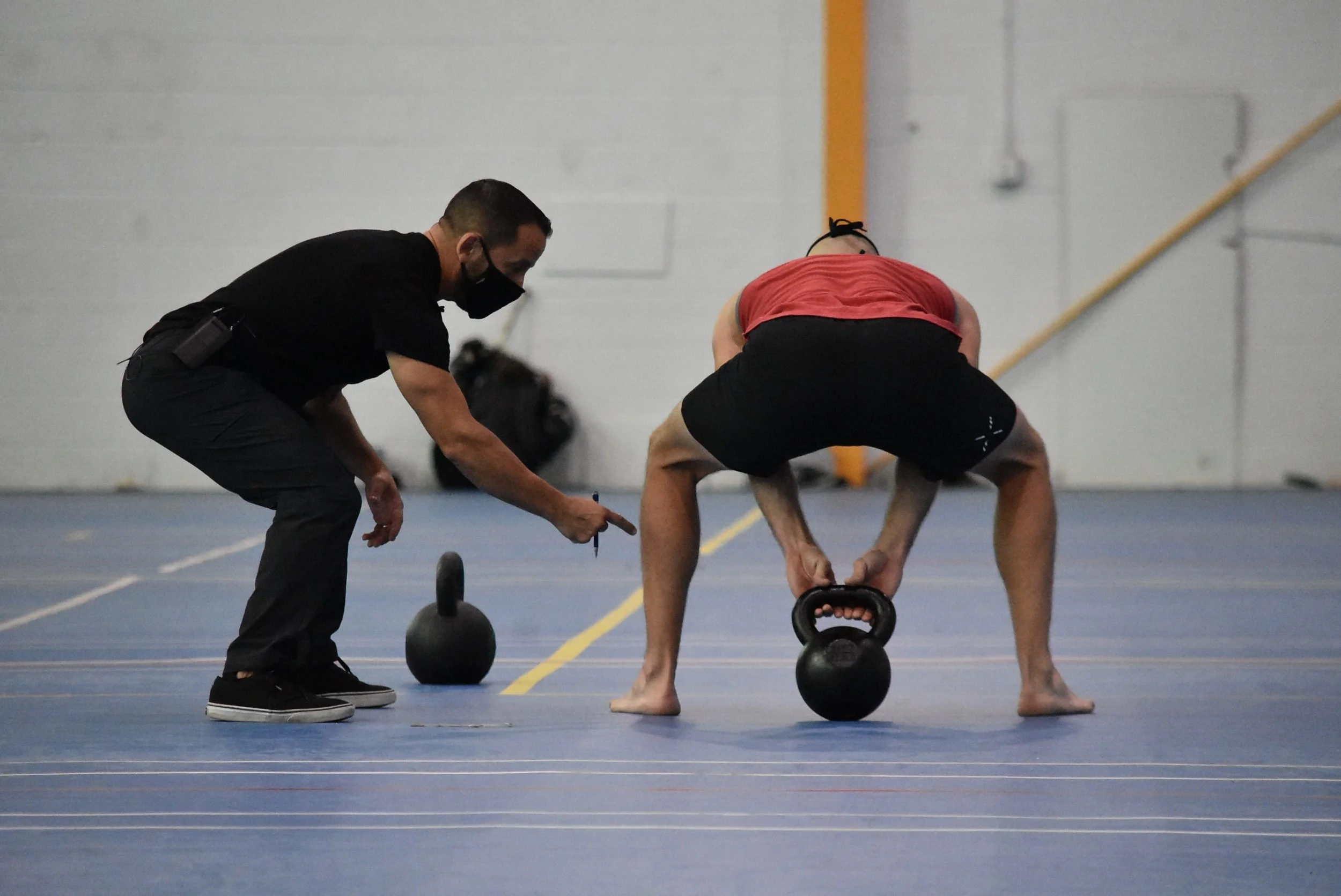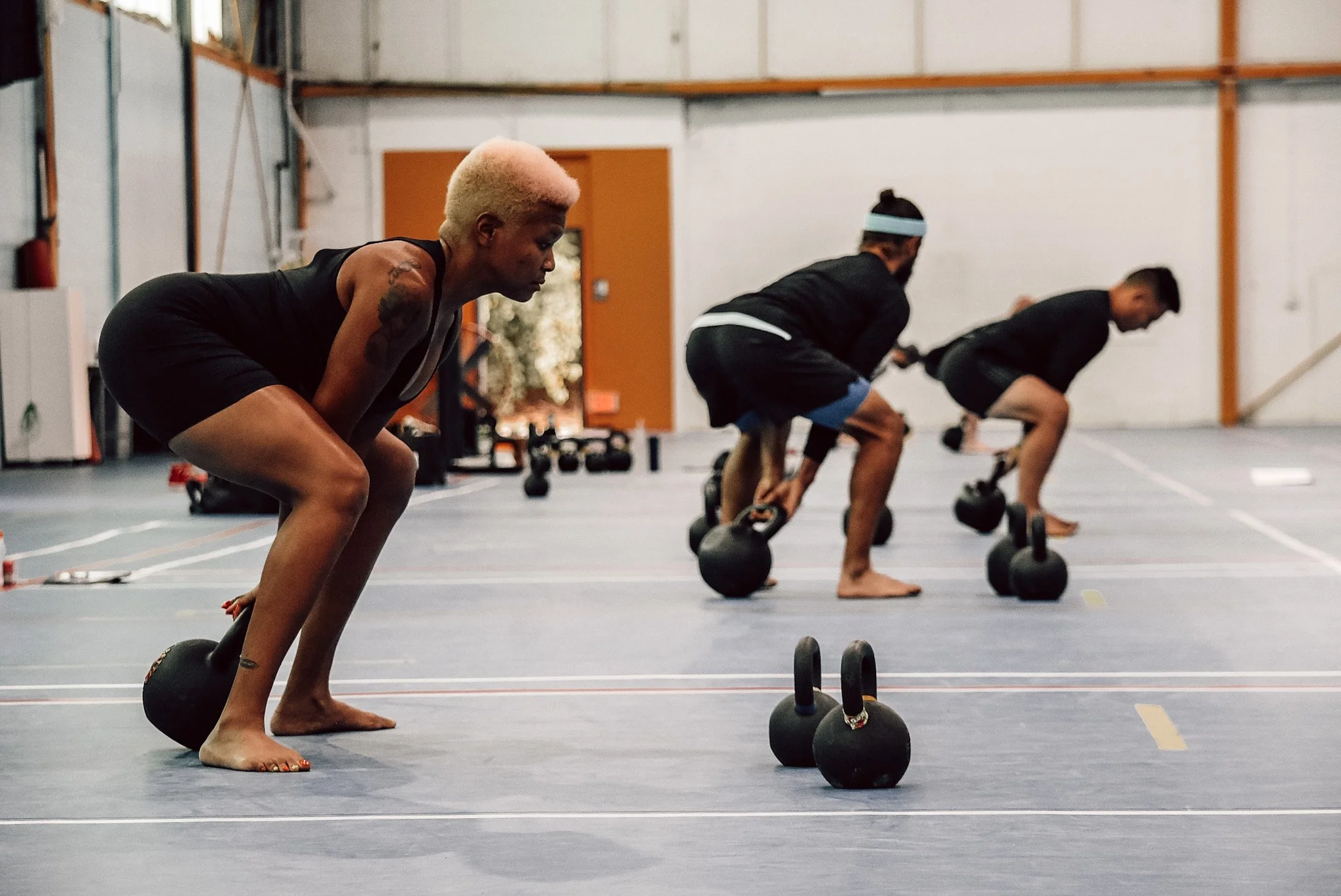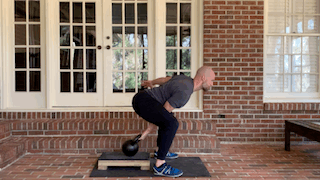Revolutionize Your Kettlebell Practice: DV8 Methods by Phil Scarito, So Effective That Other Orgs and Educators Are Taking Them As Their Own.
The DV8 Start—Kettlebells Behind the Heels & DV8 Kettlebell Movement Learning Order:
A Few of Phil Scarito’s Concepts on Kettlebell Instruction.
Above: The DV8 Kettlebell Start. DV8 Start Version: Two Arm, Single Kettlebell.
Below: Material from an iteration of DV8 Kettlebell Teaching Certification instruction material with, in part, added image content. Copywrite DV8Fitness, Inc.
As with all training, never train through pain, and be cleared through your clinician before starting. If you do not have a clinician, you can direct questions for referrals to one through our Contact Page.
DV8 Method Kettlebell Grind & Ballistics
Deadlift —> Clean —> Snatch —> Swing
The concept of the hinge is something you have heard before, but as many of us know and have seen, a hinge can mean different things to each person. For those of you who have been taught to hinge high with a slight knee bend, DV8 technique will be a game changer. For those who have more of a squat style hinge, you will feel like you are relearning the swing all over again and will develop more power in your stance.
So, we must start with the Deadlift, because the work you do here will assist you as you move into the Ballistics. Many current teachers teach a higher hip hinge style swing or deadlift. But as you will experience in practice during this weekend, if we are trying to move a kettlebell with no momentum, as we are in the DV8 Start, your hips will figure out the strongest position in order to do this. That hip position will be lower than you think.
In all of the movements above in the DV8 order of instruction (Deadlift —> Clean —> Snatch —> Swing) there is one thing in common… a solid hip hinge. Not only is it an athletic movement, meaning the ‘ready position’ in most sports, but it is a fundamental pattern that we as humans all had within us at one point. We learned early on that we couldn’t pick things up in a Squat position because we didn’t have strength yet, so we found the most efficient way, the Deadlift. As we grew older and developed our own modifications in how we move based on our way of living and even the tools we use daily (cell phones, etc.), often we have lost the inherent hip hinge pattern and developed postural compensations – frequently, dysfunction.
I believe that our body wants and craves the fundamental pattern of the Deadlift, but often does not know how to get there anymore. We need to re-teach our bodies to remember this pattern. As a strength coach, trainer, athletic trainer, clinician, or movement professional, it is our duty to at least try the best we can to establish a hip hinge with our students and athletes. Anyone can argue that it’s not the way to start a program. You could say we need to start on the ground first, work on rolling, crawling or even Squat first. In my opinion, the Deadlift is essential to daily life. We need it to get out of a chair. We need it to use a toilet. Those who now naturally neglect to use their hips have often already developed other medical issues based on their lack of ability to use their hips properly. For example, low back issues.
AGAINST THE GRAIN
My methods go against the grain of the currently popularized ways of teaching Ballistic Kettlebell movements, including where the kettlebell is in front of the student upon set-up. Currently most new systems (the last few decades when kettlebells became popularized outside of Russia) also teach the Swing before the Clean and the Snatch, as a fundamental learning order. Sound small or unimportant? There’s a huge difference to the student’s education here in the switch to DV8 Methodology that the keen learner will pick up on quickly. And differences in DV8 education only increase from there.
In DV8 Methodology, we place the kettlebell(s) behind the heels upon set-up. We teach the Deadlift first, Clean second, next the Snatch and lastly the Swing. By sequencing it this way with a bells-behind-the-heels set-up, we teach the student:
How to develop their most powerful hip hinge.
How to create starting strength which carries over into barbell training.
How to let the kettlebell path that is created by the kettlebell placement, teach proper technique.
4. The emphasis the feet/stance play in generating power from the floor up.
The way it is popularly taught now, with the Swing learned first and the kettlebells out in front of us at set-up, puts the student in a position where they cannot control the power that is created, making the education less efficient, to say nothing of the subsequent and unnecessary frustration for our student.
Essentially, when we teach this way, we are setting students up to fail from the start and then correcting from there, through drills. Occasionally it works in the Swing, because we are projecting energy out in front of us, but when it comes to the Clean and the Snatch, students tend to lose control on the way up and down, creating an often unsafe, inefficient movement pattern. This is in large part a product of teaching the Swing first, allowing the kettlebell to come away from the body, then asking the student to keep the bell close to the body for the Clean and Snatch. This is confusing and frustrating to the student. At DV8, we are eliminating the hike pass, taking away the momentum and teaching how to streamline the learning process.
OVER-COMPLICATING THE KETTLEBELL SNATCH
I continue to hear and was taught that the Snatch is the culmination of all the elements of movement that we have been taught prior in widely accepted current instruction—that it puts the Swing, Clean, and Deadlift all in one to create an explosive overhead movement. There are elements of the Deadlift and Clean that comprise the Snatch, but the Swing does not. In fact, putting emphasis on the Swing in this process let alone as a base for culmination, not only confuses the student and the body, but it distracts the student from performing the Snatch well by patterning pushing the bell away as a means of then later putting it up overhead. This is why there are so many drills and articles and videos on “taming the arc” … and arguably why that’s even a buzz phrase itself. Because it’s not taught well from the start.
The Snatch does not need to be taught last, nor is it taught as efficiently as possible in this manner. And it certainly does not need to have so much emphasis placed on it, as has been commonly done elsewhere to this point. As you may have already experienced in that scenario, most students are so nervous about the Clean and the Snatch that it becomes self defeating, and then much more difficult than necessary to perform and learn.
We don’t know if a change is now or yet made in that system, and we see more and more DV8 material filtering into the material “of old” as though it was always that way. But past educational material used to teach students exists and can be found by anyone really looking for access. Not only that, but the common issues are common issues for a reason. Snatch issues are an example, but not the only one. One thing is for sure though, where you find buzz phrases and tons of drills for correction, drills that go on for decades even, you are finding something that we can teach, learn, and practice better from the start. Luckily the recognition of this, and proper instruction, can always lead us to a way to do it better, thereby actually fixing the problem.
OVERUSE OF DRILLS AS CRUTCHES
I believe we should aim to be masters of movement, not masters of drills to fix movements taught less than ideal from the start. Though there is nothing wrong with the prior, and entire companies have been built off of it, I believe that it’s not necessary, that it’s not the most effective way to teach these movements or teach how to teach these movements, and that we can streamline the process. This is the next level as a practitioner and educator. This is what we aim to do here at DV8.
This is also truly getting back to basics.
***
So at DV8, instead we begin by outlining a system where students learn to control their movement with more ideal mechanics and education on the Deadlift and Clean initially, even before the Swing, to proof their armor in developing a solid hip hinge, a powerful hip snap, as well as an efficient and comfortable arc.
***
The DV8 Start
Bell Placement, the Details
The start position is kettlebell behind the heels. If the bell(s) are directly in line with the student’s ankles, they are too far forward.
Starting the kettlebell in this way as opposed to in front, now demands greater focus, mindfulness, and power from the feet, hips and glutes in order to get the kettlebell moving. This creates more starting strength.
Placing the kettlebell behind the heels will develop a deeper hip hinge. This is the DV8 Start.
The kettlebell placement itself is important because it determines the arc of the pull. Again, depending on the upper body mobility of each student will determine how far back they can go.
As a student practices pulling from behind, this slowly develops the arc for the Clean and the Snatch.
If the student has mobility issues in the shoulders and T-Spine, if the student is unable to straighten the spine, or if we simply want the student to get used to the feel of proper set–up here, we bring the floor up to them with a tool like a block. We are still placing the kettlebell behind them, but higher, so they establish proper shoulder and spine position.
Student maintains a long spine, looks at the floor just ahead, and tilts bell handle in the direction the kettlebell will travel, to complete set-up.
Moving the Kettlebell and Block Back Further
One thing to consider and apply is how far back should the kettlebell and block be behind the heels in the DV8 Start. Even when the kettlebell/block are placed directly behind the heels, in many cases we can move the bell even further back, as long as the student does not have to compensate for this adjustment. For example, moving the bell back further could round the spine; we do not want this. We want to have the working arm extended as far as possible so that all of the slack is taken out of the arm, producing the right amount of tension from arm to kettlebell. This will keep the student from jerking the kettlebell off of the block, causing a disconnect from the arm to the hips. This concept will be revisited again later in the section Commonly Asked Questions.
Additional Tools to Assist
The overall idea behind the block is to bring the floor up to the student and give them the best opportunity to understand and apply the kettlebell placement method in the DV8 Start. Eventually, the block will be taken away, and surely revisited again. So it is important not to consider the block as an “easier” version… it is not. It is simply a part of the conceptual learning process.
Here are the two specific tool recommendations that I find most effective. When aiming to raise the floor, these will help greatly in the execution of the Deadlift, Clean, Snatch and Swing. Always remember, it is your responsibility to stay vigilant and pay attention, making sure the tool you or your student selects for this purpose is a safe one, and is being used safely.
Weighted Blocks, Yoga or Custom - These versions help by not letting the block move, as you meet the kettlebell to the block on the hinge portion.
Bumper Plates - The bumper plates allow a larger surface area for the kettlebell(s) to land on and provide feedback on how well you hinge and absorb the weight of the kettlebells.





